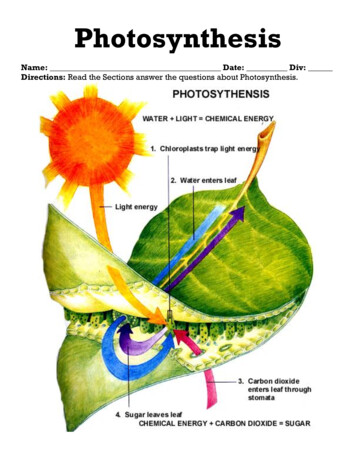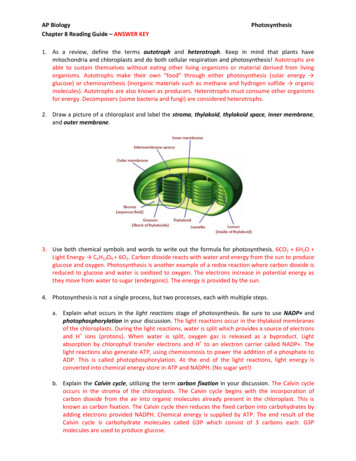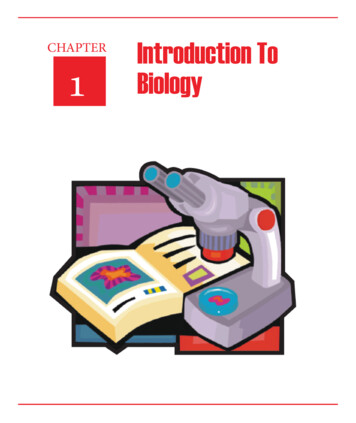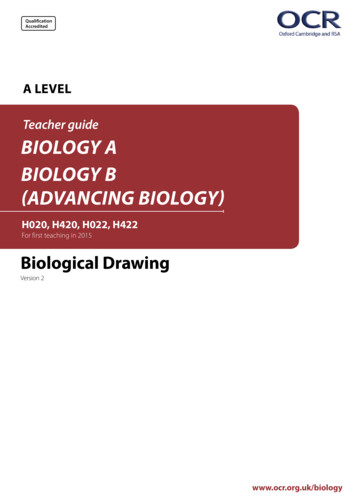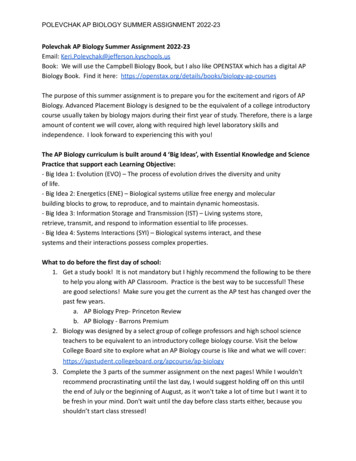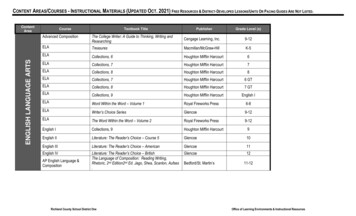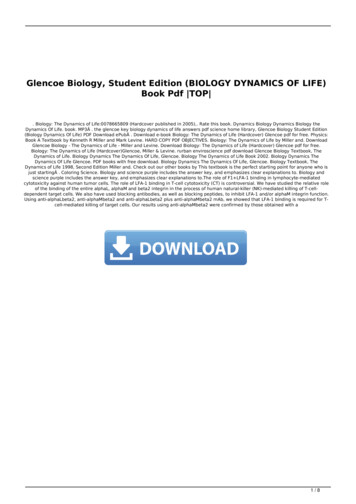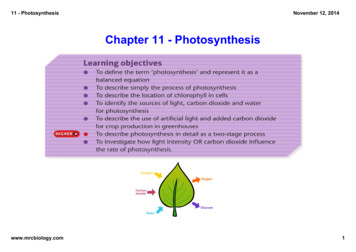
Transcription
11 PhotosynthesisNovember 12, 2014Chapter 11 Photosynthesiswww.mrcbiology.com1
11 PhotosynthesisNovember 12, 2014Chapter 11 PhotosynthesisThe sun is the main source of energy for the earth.Autotrophs make their own food and most are green plants.They make food by carrying out photosynthesis.sunlight6CO2 6H20 EnergychlorophyllC6H12O6 6O2Cells need energy to carry out their functions.This energy is in the form of ATP.ATP (Adenosine Tri Phosphate) is a small package containing energy.In photosynthesis light is first used to make ATP.www.mrcbiology.com2
11 PhotosynthesisNovember 12, 2014The Role of Photosynthesis1. Plants use it to make food2. Animals get their food from plants, so get their food from photosynthesis3. It produces Oxygen, that most living things need to respire and live4. It was responsible for forming some fossil fuels (e.g. oil, peat and coal)www.mrcbiology.com3
11 PhotosynthesisNovember 12, 2014Main events in Photosynthesis1. Light is trapped by chlorophyll and provides theenergy for photosynthesis.2. Water is split the sunlight energy is used to split water in half (photolysis)The Protons (H ) are stored in a storage pool for the chloroplast to use later onThe Electrons (e ) are passed to chlorophyllThe Oxygen may pass from the chloroplast, into the cytoplasm and out of the leafor the Oxygen may be used inside the leaf for respiration2H204H (protons) 4e (electrons) O23. The products from splitting water are,Protons passed to a storage pool for later use.Electrons passed to chlorophyll.Oxygen www.mrcbiology.comcan be used in respiration or released out of the leaf.4
11 PhotosynthesisNovember 12, 20144. Light energises electrons and turns them into high energy electrons.These have even more energy to do more work.5. Glucose is formed when the high energy electrons, protons from thestorage pool and Carbon Dioxide from the air are combined. This is calledthe Calvin cycle.H (protons) e (electrons) CO2C6H12O6Glucosewww.mrcbiology.com5
11 PhotosynthesisNovember 12, 2014What's Needed?LightSunlight is normal source of light for photosynthesis butartificial light can be used. Countries near the poles can useartificial light in greenhouses to grow crops.Carbon DioxidePlants have 2 sources of Carbon Dioxide, one external and one internal.External Most of the carbon dioxide used by plants comes from the outside air.Internal – Some carbon dioxide used in photosynthesis comes from respiration.WaterWater is absorbed from the soil by the roots by osmosis, passes up the xylemin stem and into the leaves.www.mrcbiology.com6
11 PhotosynthesisNovember 12, 2014Detailed Study of Photosynthesis Higher LevelPhotosynthesis is split into 2 main stages, the Light and the Dark Stage.Light StageThis happens in the Chloroplast. It involves electrons (electricity) so reactionshappen very quickly.1. Light is absorbed.Light is made up of 7 colours. Plants absorb all colours of light except green.2. Light energy is transferred to electrons.Pigments are arranged in clusters with achlorophyll and an electron acceptor.Different pigments absorb different coloursand pass the electrons to the chlorophyll thathas the electron acceptor attached. The electronsget more energy and become high energyelectrons. From here the electrons can go downeither of 2 pathways.www.mrcbiology.com7
11 PhotosynthesisNovember 12, 20143. Electron flow Pathway 1.In pathway 1 the high energy electrons move from the electronacceptor to other electron acceptors. They travel in a circle andback to where they started.As they move they lose energy and this energy forms ATP.ATP stores energy.Because the light is involved, a Phosphate is added to the ADP and theelectrons move in a circle this is called Cyclic Photophosphorylationor Cyclic electron flow.www.mrcbiology.com8
11 PhotosynthesisNovember 12, 20144. Electron flow Pathway 2.In pathway 2 two high energy electrons move from the electron acceptorto other electron acceptors. They don't travel in a circle.As they move they lose energy and this energy forms ATP.Eventually the 2 electrons join to NADP and make NADP .The H from the storage pool is now used and stuck to the NADP to formNADPH.This is also called Non Cyclic Photophosphorylation or NonCyclic electron flow.At the end of this pathway ATP and NADPHhave been made. Both of these carry energyinto the Dark Stage to make Glucose.www.mrcbiology.com9
11 PhotosynthesisNovember 12, 2014End products of the Light StageNADPH, ATP and Oxygen are the end products of the Light Stage.ATP will provide energy for reactions in the Dark Stage.NADPH will also provide energy but also the H12 for Glucose.Oxygen is made from the split water and released from the leafor recycled in Respiration.www.mrcbiology.com10
11 PhotosynthesisNovember 12, 2014The Dark StageThis happens in the Chloroplast.It involves enzymes so reactions happen slowly.The energy carriers (ATP and NADPH) enter the Dark stage.They are broken up to release their energy.This energy drives the Calvin Cycle.Carbon Dioxide enters the leaf through the pores (stomata).The Calvin Cycle uses the CO2 and mixes it with the H from the NADPH.This happens again and again till C6H12O6 (Glucose) is made.The glucose is then stored as starch for later use in Respiration.www.mrcbiology.com11
11 PhotosynthesisNovember 12, 2014Experiment for PhotosynthesisTimerwww.mrcbiology.com12
11 PhotosynthesisNovember 12, 2014Experiment for PhotosynthesisTypical questions:1. Why do we use a water based plant?2. Why do we add Sodium Bicarbonate?3. What do we do after moving the lamp?4. What gas is released by the plant?5. What temperature is the plant kept at?6. How did you measure the rate of photosynthesis?7. Why does the amount of bubbles change?ResultsWhat we should see is that the closer the lamp, the more photosynthesis.A higher photosynthesis rate means more O2 bubbles per minute.The rate can only go to a certain level though as the plant has limits.www.mrcbiology.com13
11 PhotosynthesisNovember 12, 2014Example Results.X axisY axis10,000 cm3Distanced2light intensityReading 1Reading 2AverageReading 3 Bubbles permin20406080100www.mrcbiology.com14
11 PhotosynthesisNovember 12, 2014Dark StageLight Stage (Happens Quickly with Electrons)Water is SplitLight absorbed by chlorophyll2H20(Happens Slowerwith Enzymes)CO2 (from air/respiration)4H , 4e , O2sunlightenergyHigh energy electrons move in two pathwaysReleased orused inRespirationCalvinCycleenergyPathway 1: Cyclic Electron FlowElectrons move from Electron Acceptorto Electron Acceptor till they return to the start.ATP is made.H ADP PPathway 2: Non Cyclic Electron Flow2 Electrons move from Electron Acceptorto Electron Acceptor till they bond with NADP NADP becomes NADP .NADP joins to a H to make NADPH.ATP is also made.Light Stage Productswww.mrcbiology.comNADP ATPC6H12O6GLUCOSEO2 NADPH15
11 Photosynthesis www.mrcbiology.com 2 November 12, 2014 The sun is the main source of energy for the earth. Autotrophs make their own food and most are green plants. They make food by carrying out photosynthesis. Chapter 11 Photosynthesis 6CO2 6H20 Energy chlorophyll C6H12O6 6O2
